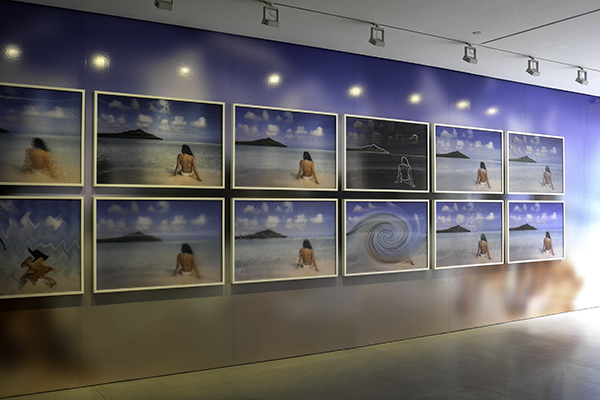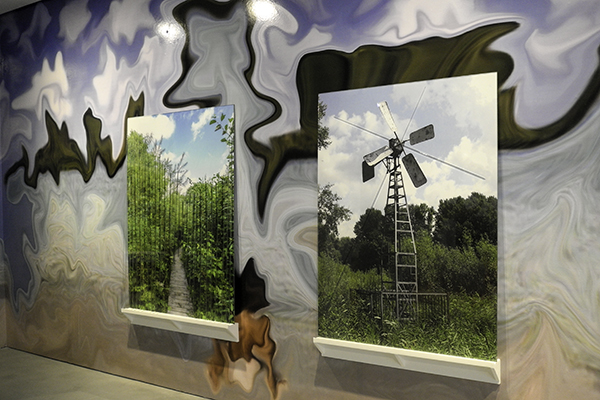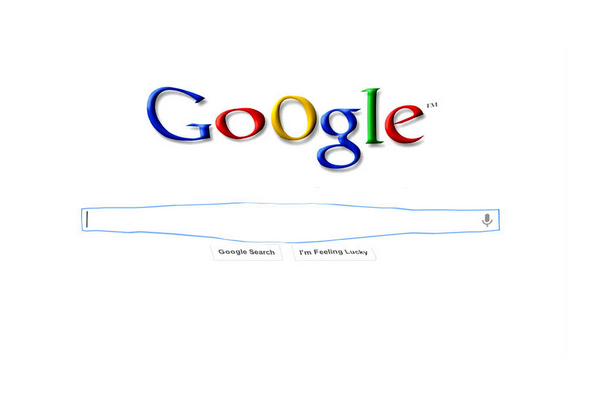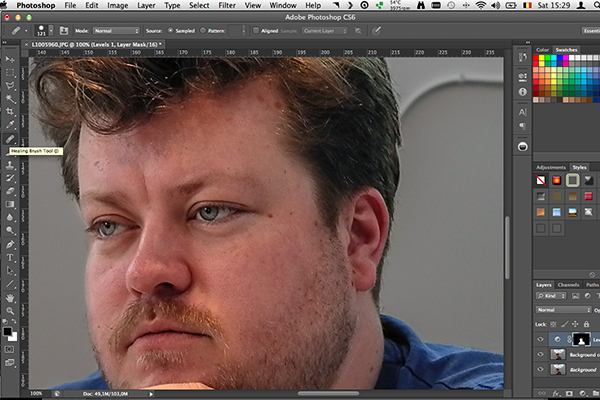Interview with Constant Dullaart
Entering Constant Dullaart’s show Stringendo, Vanishing Mediators at Carroll/ Fletcher is like stepping into a Matrix. An immersive world where Photoshop filters, brushstrokes, masks and marching ants come to life in unexpected forms, where Google search box recites its Terms of Service in a seductive voice and where a lonely piano plays an autistic version of Together in Electric Dreams.
Jennifer_in_Paradise
12 lenticular prints depicting an idyllic image of a young woman sitting on a beach get distorted, as you pass along them in the gallery. They are part of ongoing series of a total of 72, each manipulated by one of the currently available Photoshop filters. The original photograph was taken by John Knoll, the co-founder of Photoshop, in 1988 and portrays his future wife Jennifer during their vacation in Tahiti. It was this photograph that Knoll first used to demonstrate the possibilities of his new groundbreaking software.
“Jennifer has been in my life for a while now”, says Constant. Last year he tried reaching her through a beautiful personal letter, asking permission to use her photograph – that although an ancestor of all digitally manipulated images, was nowhere available – but in vain. At the end he recreated the photograph from video screenshots.
However when The Guardian newspaper interviewed the artist about his project and in parallel asked John and Jennifer Knoll for a comment, it turned out John was not getting the artistic approach of Constant. And although Jennifer seemed to appreciate that the Internet allows appropriation of her image, she categorically said no to the artist’s idea of them meeting and reliving that moment on the beach. “A bit of a sad end to a story that I was deeply involved in for the past 24 months. It feels a bit like a breakup.” laughs Constant.
The semantics of software
Jennifer_in_Paradise is part of a broader interest Constant has in the semantics that lie inside consumer software programs: “I am interested in reflecting on why certain things were developed the way they were and I want to understand the background stories of the people who took these design decisions. As an artist, I would like to help people consider the impacts of technology on our behavior and to do it through poetic means. Most of the attention today goes to the facts, such as why and how Mark Zuckerberg founded Facebook. But I am interested in how the design of Facebook changes existing relationships and in the human stories that sit behind those facts.”
He talks with passion about the need for interpretation and misinterpretation of the new cultural memes that the digital age brings. “I want to investigate how these new tools can be used as conceptual means. Take for instance the semantics of Photoshop. Why is the healing brush called “healing”? Is it to imply that there are sick images? And because the task of healing brush is to take away detail and imperfections, mostly from skin, is it to say that there is a “good skin” and a “sick skin?”
Our conversation also covers the ethical implications of using certain software and the consequences of choosing a proprietary or open source. “We now come to a critical time when we, as consumers, should make ethical decisions not just about eating meat or locally grown food, but also about things like using Skype – a software that is effectively a Trojan horse for governments to spy on innocent citizens who think they have free access to communication.”
Quantification of emotions
Such ethical decisions also come back to how we deal with images. Big corporations such as Adobe have made it possible to run powerful image manipulation software on accessible consumer hardware. “But giving a mass audience access is not innocent, since the architecture of the software is actively influencing what users are able to do with it and the narrative they can create. In that sense, the industrialisation of image manipulation that Photoshop enabled is actually a form of corporate cultural imperialism” says Constant.
“Another example is Instagram. I liked it at first as purely visual platform, but as soon as we start adopting the features such as filters, likes and comments, it influences the way we looks at pictures. Suddenly it is not just about my picture and what I saw or felt at that point in time… I realize that I start evaluating it on the number of likes it gets, I start thinking about who will comment on it, how will it reflect on me…and that’s where it gets tricky. It is that quantification of emotions that fucks with our minds.”
Bill Atkinson, TOS and Balconism
Constant’s favorite pieces in his London show are the ones paying tribute to Bill Atkinson – the creator of MacPaint and inventor of the “drop-down” menu, the “undo” function or the HyperCard. One of them is the Hamm’s Ripple beer sign, which inspired Atkinson to create the “marching ants selection” feature. Others show Atkinson’s nature photographs animated with these marching ants selection paths.
“Bill is a living legend. He created – as a designer and computer engineer at Apple from 1978 till 1990 – some of the most important graphical user interface elements that we take for granted today. I am very happy I could work with him. He is a normal 63-years’ old guy living in San Francisco, but talking to him is like talking to a guy who invented the bicycle!”
Terms of Service is part of a series of works about the continuously changing conditions of several Internet services. The TOS‘s (Terms of Service) define our relationship with companies such as Google, but contrary to a normal relationship where you have an open discussion if the existing “status” changes, Google amends the nature of the relationship unilaterally. You could perhaps find a tech blog or the odd email that explain these changes in detail but most users just implicitly accept them. By hiring a speaker on Voices.com and letting her read out loud the TOS, Constant uses a radical form of anthropomorphisation to critique this lack of transparency.
There are also two balconies mounted on the gallery walls and a text of the Balconism manifesto is projected by RGB laser light on the concrete walls of the staircase. “It’s a long story” Constant tells us. “When talking about the Internet, people use analogies of space – cyber space, the web, chat rooms. It feels like we need to introduce a spatial reference to understand where information collects. When I saw Julian Assange standing on a balcony of the Ecuadorian Embassy in London, I suddenly thought: we are not standing on the threshold of a new space, we are standing on the balcony. We cannot enter this new space, we can peek into it and we need to make a conscious decision if we are going to stand up and speak out or if we are going to sit and watch.”
A paragraph from his manifesto sums it nicely up: “The balcony is both public and private, online and offline. It is a space and a movement at the same time. You can be seen or remain unnoticed, inside and outside. Slippers are ok on the balcony.”
On the threshold
Computer graphics and designs that changed the course of history are recurring theme in Constant’s work: Jennifer_in_Paradise is the first photoshopped image, another of his works refers to Utah Teapot, which is the first 3D computer model. We wonder what would he like to create for the first time, if money and technology were not a barrier? “Actually I am much more interested in contextualizing” says Constant. “In a weird way I am almost allergic to the ambition of being the first. There is already so much shit out there… instead of creating more, I would rather help the world dealing with what already exists.”
Stringendo, Vanishing Mediators runs at Carroll/Fletcher, London, till 19 July 2014.
_____
constantdullaart.com
@constantdull
_____
BIO
Constant Dullaart (*1979) studied the Gerrit Rietveld Academie and the Rijksacademie in Amsterdam. Recent solo exhibitions include Brave New Panderers at XPO gallery in Paris, Jennifer in Paradise at Future Gallery in Berlin and Onomatopoeia at Utah Museum of Contemporary Art, Salt Lake City. Group exhibitions include Casting A Wide Net at Postmasters, NYC, Online Mythologies at Polytechnic Museum, Moscow, Genius without Talent at De Appel, Amsterdam and Off the Record at Stedelijk Museum Amsterdam. He lives and works in Amsterdam and Berlin.
_____________________
Elastic Minds is a series of interviews about creative people working at the intersection of various disciplines. With these interviews we would like to explore the network of these creatives and add an element of chance by giving each of them the power to select the next person. Rather than static players chosen by us, they become dynamic parts in the system, able to define the evolution of the entire project.
Other Elastic Minds interviews:
Tobias Klein (October 2012)
Ruairi Glynn (November 2012)
Ollie Palmer (December 2012)
Cohen Van Balen (June 2013)





SOURCE: Happy Famous Artists » Blog - Read entire story here.
Read More







